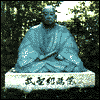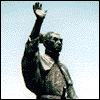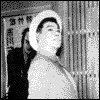Other historical figures
TAKENO Joo (1502-1555)

TAKENO Joo was a wealthy merchant from Yamato (present day Nara Prefecture), who later moved to Sakai. He was also considered to be a master of tea ceremony second to Shuko Murata and trained leading experts such as Sen-no-Rikyu, TSUDA Sogyu and Sokyu Imai. He was acquainted with KITAMUKI Dochin, who taught Sen-no-Rikyu. He also helped Dairin Soto, the 90th chief priest of Daitokuji Temple, to build Nanshuji Temple. His tomb is at Rinkoji Temple.
TSUDA Sogyu (Died in 1591)
Tea Ceremony Master of Sakai and a marchant of exceptional influence born into the Tennoji Clan of the Ego Group. Taught the tea ceremony by his father, TSUDA Sotatsu, Sogyu served Nobunaga together with IMAI Sogyu and Sen-no-Rikyu. Later as Hideyoushi's Tea Master, he was given a bounty of rice equaling 3,000 Goku (1 Goku approx. 50 kgs.) In his house are many famous implements used in the Tea Ceremony together with many amusing anecdotes of the Tea Ceremony.
IMAI Sokyu (1520-1593)
IMAI Sokyu is said to be one of the three great masters of tea ceremony, together with Sen-no-Rikyu and TSUDA Sogyu. He was a wealthy merchant from Yamato who came to Sakai, and learned sado from TAKENO Joo. He also married Takeno's daughter. Making full use of his business ability he served Nobunaga a powerful samurai who was attracted by the wealth of sakai merchants. His tomb is at Rinkoji Temple in Minamihan-cho Sakai.
NAYA Sukezaemon (date of birth and death unknown)

NAYA Sukezaemon was a trader in Ebisu-cho, Sakai in the late Muromachi Period. He went to the Philippines in l593 and returned the next year. He dedicated a bamboo paper umbrella and a rare pot to TOYOTOMI Hideyoshi. It has been said that NAYA gained huge profits by trading such precious pots, but later escaped to Cambodia because his luxurious lifestyle made him lose favor with Hideyoshi.
KONISHI Yukinaga (Died in 1600)
KONISHI Yukinaga was a son of KONISHI Ryusa, a pharmacist in Sakai. Like his father he was a Christian. whose Christian name was Agostigne. After distinguishing himself in battle , he gained the trust of trusted by TOYOTOMI Hideyoshi and in 1588 was appointed feudal lord of Udo (present day Kumamoto Prefecture), a fief yielding 43,200 kikoliters of rice, in 1588. There is still a pine tree at the Romon (two-storied gate) of Sugawara Shrine which is said to have been planted by Yukinaga himself.
SHIBATSUJI Riemon (Died in 1634)
SHIBATSUJI Riemon, a foremost gunsmith, was born into a gunsmith family in Sakai. One of his ancestors Seiemon made the first gun in Sakai. He made the first iron cannon in Japan for TOKUGAWA Ieyasu in 1611. His descendants continued to manufacture guns until the end of the Edo Period.
ENAMIYA Kanzaemon (Died in 1643)
ENAMIYA Kanzaemon was born into a gunsmith family and succeeded the family business in Sakai. He was given an important position as a gunsmith for the government when TOKUGAWA Ieyasu began the Tokugawa Shogunate in Edo (present day Tokyo). He was one of Tokugawa's first senior statesmen who was in charge of guns.
KAWAI Suimei (1874-1965)

A poet born into a family of kimono fabric dealers on Daido Avenue. He wrote new-style poetry and tanka (31-syllable Japanese poems) from around 1887. He published his first anthology, "Mugenkyu" in January 1901, and his second one, "Toei" in June 1905. Both were mainly filled with poetry form in the seven-five syllable meter fixed form. In 1910, he published his book of free verse, "Kiri". He was nominated as a member of the National Art Academy in 1937, and an honored member of Japan Poets Club in 1950. His achievements in supporting the education of women poets are also praised.
SOGANOYA Goro (1877-1948)

A man of tenacity who stood on the stage with pharyngeal cancer. SOGANOYA Goro was born in Shukuin-cho, Sakai. His real name was WADA Kyuichi and he had another name, IKKAI Ryojin. He performed a new style of comedy, "Gorogeki" after realizing that he could not succeed as a kabuki actor. He toured various regions as an itinerant actor. He wrote and performed more than 1,000 plays. He enjoyed a long reputation as the "King of Comedy".
